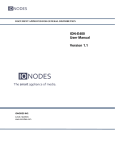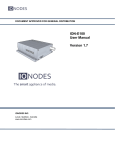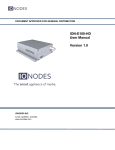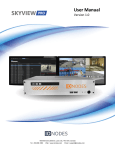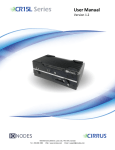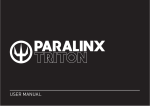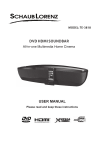Download ION-R100 - User Manual
Transcript
DOCUMENT APPROVED FOR GENERAL DISTRIBUTION ION-R100 User Manual Version 1.9 IONODES INC. www.ionodes.com Table of Contents 1 2 BEFORE YOU BEGIN ............................................................................................................................... 3 1.1 ABOUT THE ION-R100 .......................................................................................................................... 3 1.2 PARTS LIST ............................................................................................................................................ 4 HARDWARE INSTALLATION ............................................................................................................... 5 2.1 3 EQUIPMENT INSTALLATION.................................................................................................................... 5 CONNECTIONS ......................................................................................................................................... 6 3.1 REAR PANEL .......................................................................................................................................... 6 3.2 FRONT PANEL ........................................................................................................................................ 7 4 SERIAL PORT CONNECTIVITY .......................................................................................................... 10 5 UNDERSTANDING LED STATUS ........................................................................................................ 12 6 DEVICE CONFIGURATION .................................................................................................................. 13 7 6.1 NETWORK CONFIGURATION ................................................................................................................. 13 6.2 USING THE ION-R100 WEB INTERFACE .............................................................................................. 17 6.2.1 Setting up the NTP time server....................................................................................................... 18 6.2.2 Configuring video output parameters ............................................................................................. 19 6.2.3 Point to Point Connections ............................................................................................................. 23 PERFORMING A FIRMWARE UPDATE ............................................................................................ 28 7.1 BATCH FIRMWARE UPDATE ................................................................................................................. 29 QUICK SETUP GUIDES .................................................................................................................................. 32 7.2 1X1 HDMI LAYOUT W/ IP CAMERA .................................................................................................... 32 7.3 2X2 HDMI LAYOUT W/ FOUR IP CAMERAS ......................................................................................... 34 7.4 1X1 SEQUENCE HDMI LAYOUT W/ FOUR IP CAMERAS ....................................................................... 36 ANNEX A – CONFIGURATION PARAMETER REFERENCE ................................................................. 38 ANNEX B – TROUBLESHOOTING GUIDE ................................................................................................ 39 ANNEX C – STATEMENT LIMITED WARRANTY ................................................................................... 40 ION-R100 – User manual 1 Before you begin 1.1 About the ION-R100 The ION-R100 single port decoder delivers high quality H.264/MJPEG video decoding and display to the video surveillance market. It is an embedded, high-performance digital video decoder, capable of decoding H.264/MJPEG video to an analog (SD) or HDMI (720p/1080p) display. Embedding support for networked API‟s, the ION-R100 can be integrated into a networked video management system allowing for centralized monitoring and management in a scalable and expandable IP surveillance system. Contact IONODES for a list of supported VMS systems. The high-performance decoding capabilities of the ION-R100 offer a cost-effective way to decode and display analog and digital camera streams while providing the benefits of video over IP networks. The ION-R100 provides innovative configuration options and tools that can significantly decrease the amount of time and effort required to deploy a unit. Using web-based configuration tools, users can easily and remotely manage all aspects of the appliance. To support high-performance decoding, while keeping the total cost of ownership within budget constraints, the ION-R100 uses highly efficient H.264 stream decompression and supports optional MJPEG stream decoding as well. Combined with the IONODES line of IP-based video encoders, the ION-R100 provides the ability to create fully functional point-to-point links. The ION-R100 is also fully compatible and can decode H.264/MJPEG video streams provided by most third-party IP cameras and video encoders on the market. Page 3 of 40 ION-R100 – User manual 1.2 Parts List Qty Description 1 ION-R100 appliance 1 Terminal block socket (P/N Weidmuller 1727660000 or 1727580000) Note: When unpacking, inspect the shipment box and appliance to identify any possible damages due to shipping. Make sure all items have been delivered and that no items are missing. Contact your IONODES representative should you find any damages or defects. Note: The product serial number label helps the IONODES product support team identify your device and its factory configuration in the event that your ION-R100 or its components require service. The label is attached on the underside of the enclosure. . Page 4 of 40 ION-R100 – User manual 2 Hardware Installation 2.1 Equipment Installation The ION-R100 can be placed on a flat surface, such as a desktop, or mounted via the available mounting holes. When installing the ION-R100, position the unit to allow for cable clearance at the front and rear of the unit. Make sure that minimal air flow is provided to the unit. The ION-R100 can be mounted to various mounting structures via the available mounting holes. Note that mounting screws are not shipped with the device. Warning: Be careful not to damage the enclosure when using mounting screws. Page 5 of 40 ION-R100 – User manual 3 Connections Familiarize yourself with the ION-R100 front and rear panels before connecting any equipment to the unit. The ION-R100 offers an analog video output, an HDMI video output, and associated I/Os and audio connections. 3.1 Rear Panel VIDEO OUT BNC connector interface for video output to analog display (NTSC / PAL). HDMI OUT HDMI connector interface for video output to digital display (720p/1080p). Note: Not all HDMI displays with function with the ION-R100; contact your IONODES representative for more information. Page 6 of 40 ION-R100 – User manual 3.2 Front Panel Terminal Bloc Header Terminal Bloc Header This header connector is used to connect the supplied Terminal Bloc Socket which provides the interface to serial port, I/O and power connections. Below is a detailed view of this Terminal Bloc Socket: Relay Output Digital Input Pins #1 & #2 Receiver pair for serial communication (4 wire RS-422 or RS-485) Transmitter pair for serial communication (4 wire RS-422 or RS-485) 12V power source RL I1 Rx+ Tx+ 12v RL I2 Rx- Tx- GND Page 7 of 40 ION-R100 – User manual The pin out description of the Terminal Bloc Socket is as follows: Number Description Direction 1 RL (Relay) Out 2 RL (Relay) Out 3 I1 (Digital Input 1) In 4 I2 (Digital Input 2) In 5 RX+ In 6 RX- In 7 TX+ Out 8 TX- Out 9 12V supply In 10 Ground - AUDIO IN / OUT 3.5 mm jack which can be used to connect both an audio input and an audio output source. The stereo channel provided by this connector exposes one channel for the audio input and the other for the audio output. Line In Line Out Ground STATUS The system status LED is a bi-color (Red - Green) LED providing detailed information on the current state of the device. ETHERNET / PoE This is the ION-R100 network port. Please use a straight RJ45 (cat. 5 or 6) network cable. The ION-R100 accepts a Power-Over-Ethernet (PoE) compliant power source if needed. Page 8 of 40 ION-R100 – User manual RESET The reset button can be used to perform a hardware reset, or to perform a complete reset to default settings of the device‟s configuration parameters. Page 9 of 40 ION-R100 – User manual 4 Serial Port Connectivity Many devices (PTZ keyboards, PTZ cameras, etc.) use RS-422/485 protocols for communicating with other equipment. These protocols are standards for binary data exchange between DTE and DCE equipments. To connect serial equipment to an ION-R100 using RS-422/485 4-wire configuration, use the following steps: 1. Connect twisted pair cables to the Terminal Bloc Socket located on the front panel of the device. Connect to Tx+, Tx-, Rx+, Rx- and GND. 2. Select the desired operation mode (RS-422 4-wire, RS-485 2-wire or RS-485 4-wire) using the devices web interface or external VMS interface. 3. To ensure proper connection between RS-422 4-wire or RS-485 4-wire serial equipment and the ION-R100, use the following scheme: Equipment Serial Port ION-R100 Serial Port TX+ RX+ TX- RX- RX+ TX+ RX- TX- GND GND Page 10 of 40 ION-R100 – User manual To connect serial equipment to an ION-R100 using RS-485 2-wire configuration, use the following steps: 1. To create the negative data signal, please connect Rx- and Tx- pins together on the Terminal Bloc Socket. 2. To create the positive data signal, please connect Rx+ and Tx+ pins together on the Terminal Bloc Socket. 3. To ensure proper connection between RS-485 2-wire serial equipment and the IONR100, use the following scheme: Equipment Serial Port ION-R100 Serial Port Data + Data + Data - Data - GND GND Page 11 of 40 ION-R100 – User manual 5 Understanding LED Status The following describes the system status LED mappings of the ION-R100: Normal Operation: Operating system boot up – LED is steady orange (max. 60 seconds) Internal application startup – LED is flashing orange (2 second interval) ION-R100 system ready – LED is steady green Media streaming – LED is flashing green (1/2 second interval) Special Operations: Identify command received – LED is flashing orange/green Hardware reload default settings – LED is flashing rapidly red/green Software watchdog is rebooting the appliance – LED is flashing rapidly red Firmware update in progress – LED is flashing slowly red/green Note: Under normal operation, the ION-R100 takes up to 1-2 minutes to boot up. Page 12 of 40 ION-R100 – User manual 6 Device Configuration The ION-R100 needs to be configured prior to using it on your video network. When using the ION-R100 in combination with a compatible video management software (VMS) solution, only network configuration will most likely be required since other device settings will be managed by the VMS itself. In this case, network configuration is required in order to allow the VMS to locate the device on the network. In cases where the ION-R100 is used in a standalone configuration (such as point to point connection with one or more IP cameras), basic video output and connectivity settings will need to be set-up through the device‟s web interface, in addition to network configuration. In this case, the device will keep this configuration within its internal memory and act as a fully standalone video decoding & display appliance. Device configuration can be applied using a laptop directly connected to the device‟s network port, or connected remotely over the network. 6.1 Network Configuration By factory default, the ION-R100 is configured in DHCP. If you are not using a DHCP server it will automatically allocate itself an APIPA (Automatic Private IP Addressing) address in the range 169.254.0.1 to 169.254.255.254 with subnet mask 255.255.0.0. Initial device network configuration is done via the IonConfigTool (ICT), a tool provided by IONODES and that can be found on the IONODES web site at www.ionodes.com. The ICT plays 5 important roles: 1. Discovery of all ION-R100 and other IONODES devices on the network 2. Remote configuration of the IP address and subnet mask Page 13 of 40 ION-R100 – User manual 3. Identifying an IONODES device by flashing its LED (red/green) 4. Applying batch firmware upgrade of all common IONODES devices 5. Accessing a device‟s web based management interface Once your device is installed on your network and powered up, launch the ICT from any computer located on the same network as the device. The ICT supports 2 methods for discovering a device on the network. The first method doesn‟t require any configuration and uses the Bonjour discovery protocol. In order to be able to discover a device via Bonjour, the network must support multicast IP. If multicast is not supported, you can use the second method: Unicast Discovery. Unicast Discovery can be configured by using the “Unicast Discovery” menu option under the Admin menu list. Page 14 of 40 ION-R100 – User manual To configure Unicast Discovery, add one or more IP address ranges. Unicast Discovery will attempt to reach a device at a specific IP address in the configured ranges. Discovery can be a long process if the range of IP addresses is large. To accelerate the discovery, add several small ranges of IP addresses. The ping timeout option can be increased for a high latency network. The ICT will display as many devices as it discovers on the network. Page 15 of 40 ION-R100 – User manual If no DHCP server was able to assign an IP address to an ION-R100, it will appear in the ICT device list with an APIPA address (169.254.*.*). If an ION-R100 displays an APIPA address it must be configured with a valid IP address before it can be used on the network. Select the „‟Assign IP address‟‟ from the selection list and apply the desired TCP/IP settings to the device. Once the TCP/IP settings are set, the web-based configuration interface of the ION-R100 can be launched from the ICT or directly in your web browser by typing the device‟s IP address in the address bar. Page 16 of 40 ION-R100 – User manual 6.2 Using the ION-R100 Web Interface When accessing the device‟s web interface, you will be asked to enter a username and password. The factory default user name and password are both „admin‟. The following window will be displayed: The following parameters may need to be programmed before using the unit: 1. NTP time server 2. Video output parameters Page 17 of 40 ION-R100 – User manual 6.2.1 Setting up the NTP time server Under the Configuration section, select the Network tab and set the proper NTP server address under the NTP Configuration header. Click the Save button to apply the changes. Page 18 of 40 ION-R100 – User manual 6.2.2 Configuring video output parameters By default, the ION-R100 is configured to output video to the analog output port (BNC). Should you want to use high-definition HMDI output, you may change the Output Connector parameter to HDMI as shown in the image below. Page 19 of 40 ION-R100 – User manual When the BNC output connector is selected, the desired Output Analog Standard (NTSC or PAL) can be selected as shown below to match your display monitor: When the HDMI output connector is selected, the desired Output Digital Format can be selected as shown below to match your HDMI display monitor: Page 20 of 40 ION-R100 – User manual By factory default, the ION-R100 is configured as a single video stream decoder in a 1x1 output layout. In this mode, the ION-R100 is capable of connecting to a single H.264/MJPEG IP video source only, which it will decode and display in full screen on the configured output connector (BNC or HDMI). However, this is the only mode in which the ION-R100 will be able to decode an HD video source in resolutions up to 1080p30/720p60. The output layout can however be changed using the Output Layout parameter. The other possible layouts are 2x2 or sequence, which both enable use of up to four (4) video stream decoders simultaneously. When the output layout is set to 2x2 or sequence, four (4) video streams decoders are made available and can all decode and display simultaneously. In this mode, the ION-R100 is capable of connecting to four H.264/MJPEG IP video sources simultaneously, which it will decode and display in either a tiled 2x2 layout or full screen sequence on the configured output connector (BNC or HDMI). However, this mode limits the supported video source resolutions to D1 for each of the four video stream decoders. Page 21 of 40 ION-R100 – User manual When setting the output layout to sequence, the video stream decoders are displayed one at a time in full screen, following the order specified by the Sequence Order parameter, for a time interval specified by the Sequence Interval parameter. Note: Remember to click the Save button to apply any changes. Warning: Note that certain parameter changes (such as changing output modes from BNC to HDMI or vice versa) may require that you reboot the ION-R100 before the changes are applied. Page 22 of 40 ION-R100 – User manual 6.2.3 Point to Point Connections Using point-to-point connections, the ION-R100 decoder can act as a fully standalone video decoding appliance. This can be useful, for instance, in situations where the decoder is used to drive a spot monitor for IP-based video streams. Configuration of point-to-point connections should be done after the desired video output parameters have been set and applied. Video output parameters define the output type (BNC or HDMI) as well as decoder layout (1x1, 2x2 or sequence) of the ION-R100. Depending on the selected output layout, a set number of video stream decoders will be made available for configuration of point-to-point settings. Page 23 of 40 ION-R100 – User manual For each video stream decoder, a set of parameters can be set and a point-to-point connection can be configured and enabled. The Decoder Starve parameter allows you to select the behavior of the video stream decoder when no H.264/MJPEG stream is being decoded for display. Selecting Background will cause the decoder to display a background color (color selected for video output) when there is no stream to decode and display. Selecting Last Decoded Image will cause the decoder to display the last decoded video frame as a still image when there is no longer a stream to decode and display. Page 24 of 40 ION-R100 – User manual For each video stream decoder, you may set-up a point-to-point connection with an H.264/MJPEG IP camera or video encoder. To enable the point-to-point connection, you must first select the appropriate Codec (H.264 or MJPEG) which matches the video stream source and check the Enabled checkbox. You may optionally add a Description to identify the point to point connection for future reference. Page 25 of 40 ION-R100 – User manual The next step in setting up a point-to-point connection for a video stream decoder is selecting the desired Connection Type. When in Active mode, the video stream decoder will establish a connection directly to a video stream source (HTTP or RTSP), such as an IP camera or IP video encoder, and request the required video streams. When in passive mode, the ION-R100 does not establish any connection; it simply opens up a listening network port and waits for an incoming stream (RTP). The active mode supports the following video sources (IP camera or encoder): MJPEG over HTTP H.264 over RTSP/RTP/UDP Unicast H.264 over RTSP/RTP/UDP Multicast The passive mode supports the following video sources (IP camera or encoder): H.264 over RTP/UDP Unicast H.264 over RTP/UDP Multicast The settings available for a point-to-point connection are: Connection Type: Indicates which type of point-to-point connection the decoder will be use. Available choices are Active or Passive. Enabled: Indicates whether this connection is enabled or not. Description: Free-form user description of the connection, not used by the device. In Passive Mode: o Use Multicast: Determines if the incoming video stream is of multicast IP type. o Source Port: Network port to listen on for incoming video. This value must match the video stream destination port value of the IP video source. For example, if an IP camera is configured to stream its video to port 555 of the IONR100, the Source Port should be set to 555. In Active Mode: o Active Connection Status: Current status of the active point-to-point connection. Read-only value for diagnostics purposes. Page 26 of 40 ION-R100 – User manual o Connecting: a video connection is in progress with the stream source Connected: a video connection is established with the stream source Invalid: an error occurred while processing the URI Server Not Found: the streaming source is unreachable Unauthorized: provided credentials are refused by the streaming source URI Not Found: the provided URI is unknown by the streaming source Unsupported Compression: the stream source codec is unsupported Active Connection URI: URI which should be used to access a video stream from the IP streaming source. An HTTP or RTSP connection URI is accepted. The URI could contain the credentials necessary to establish a connection. Ex: rtsp://[username]:[password]@[ipaddr]/h264. Once all the settings have been set, click on Save at the bottom of the page to apply them. Some of the above changes may require a device reboot before they take effect. Once rebooted, the ION-R100 will create the point-to-point connection as configured. Note: IONODES performs regular testing on HTTP and RTSP streaming devices (IP cameras and encoders) to validate compatibility with the ION-R100. For a complete list of tested devices and associated URI‟s, please contact IONODES or visit www.ionodes.com. Warning: The ION-R100 web interface has been tested and validated with Microsoft Internet Explorer 8.0 and above. Using other browsers may not produce incorrect behaviour. Page 27 of 40 ION-R100 – User manual 7 Performing a Firmware Update This section describes how to update your ION-R100 to newer firmware versions from the web application. 1. Navigate to your device‟s web application using your favorite web browser. 2. Click on the Maintenance tab. 3. Click on the Update button. You will be asked for the firmware update file; please select the .iof file which was provided by IONODES. 4. You will see the following messages indicating the status of the update: o Firmware upload in progress... (100%) Lasts around 95 seconds. Status LED is green. o Firmware uploaded. Saving to internal storage... (0%) Lasts around 45 seconds. Status LED is flashing red-green. o Validating and decompressing firmware... (0%) Lasts around 105 seconds. Status LED is flashing red-green. o Firmware ready for installation. Rebooting device... (0%) Web page will disconnect from device until device has rebooted. You will be prompted for login once the device is up again. Lasts around 110 seconds. Status LED is orange. o Testing firmware stability... (26%) Lasts 120 seconds. Status LED is flashing red-green. o Firmware update complete. (100%) Page 28 of 40 ION-R100 – User manual 7.1 Batch Firmware Update This section describes how to perform a batch update of multiple ION-R100 devices to newer firmware versions from the ICT. The batch firmware update works by starting a firmware update session. Only one session at time is allowed and only 20 devices can be selected by session. From the ICT, select one or more devices of the same type. By using the right mouse button on the selected devices, choose the “Firmware Update” menu option. Page 29 of 40 ION-R100 – User manual To start a firmware update session, choose the “.iof” file corresponding to the new firmware by clicking to the “Select File …” button. Once selected, click to the “Start” button. Once started, the “Firmware Update Session” window shows the progress of the firmware update. This window can be closed at any moment without losing the current session. Page 30 of 40 ION-R100 – User manual If closed, the progress of the current session can be followed by reopening the “Firmware Update Session” window by clicking the button from the “Tools” toolbar. Once done, clear the current session from the “Firmware Update Session” window and restart a new session if needed. Page 31 of 40 ION-R100 – User manual Quick Setup Guides 7.2 1x1 HDMI Layout w/ IP Camera This quick setup guide assists you in quickly setting up the ION-R100 for use as a spot monitor in 1x1 output layout on an HDMI display for use with an IP camera. 1. Connect an HDMI cable between the ION-R100 and your HDMI display. 2. Connect the ION-R100 to the PoE switch using a Cat5/6 network cable. 3. The ION-R100 will power on (via PoE). Wait for the front status LED to turn green. 4. Connect your workstation to the same network as the ION-R100. 5. Launch the IonConfigTool on the workstation (found at www.ionodes.com). 6. The IonConfigTool should discover and list the ION-R100. 7. Apply the desired TCP/IP network parameters to the ION-R100 (static IP recommended). 8. Open a web browser on the workstation at type in the IP address of the ION-R100. 9. Login to the ION-R100 web interface (default is admin:admin). 10. Navigate to the Configuration / Video Out configuration section. Page 32 of 40 ION-R100 – User manual 11. Under the General sub-section: a. Set the Output Connector to HDMI. b. Set the Output Digital Format to the desired resolution. c. Set the Output Layout to 1x1. 12. Under Decoder Selection: a. Select Decoder 1. b. Select the appropriate Codec which matches the IP camera stream. c. Mark the Enabled checkbox. d. Select Active for Connection Type. e. Type the URI for your IP camera stream in the Active Connection URI field. (For list of URI’s per IP camera manufacturer, visit www.ionodes.com) 13. Click the Save button at the bottom of the configuration section. 14. The above changes will require a device reboot. Power cycle the ION-R100. 15. Wait for the status LED on the front plate to turn green. 16. Open a web browser on the workstation and navigate to the Configuration / Video Out configuration section of the ION-R100. 17. The Active Connection Status field should display Connected to indicate a successful connection between the ION-R100 and your IP camera. 18. You should now see video on the HDMI display. 19. Your ION-R100 is now configured in point-to-point with your IP camera and will re-initiate the video stream connection upon boot-up without any software assistance or human interaction. Page 33 of 40 ION-R100 – User manual 7.3 2x2 HDMI Layout w/ Four IP Cameras This quick setup guide assists you in quickly setting up the ION-R100 for use as a spot monitor in 2x2 output layout on an HDMI display for use with four IP cameras. 1. Connect an HDMI cable between the ION-R100 and your HDMI display. 2. Connect the ION-R100 to the PoE switch using a Cat5/6 network cable. 3. The ION-R100 will power on (via PoE). Wait for the front status LED to turn green. 4. Connect your workstation to the same network as the ION-R100. 5. Launch the IonConfigTool on the workstation (found at www.ionodes.com). 6. The IonConfigTool should discover and list the ION-R100. 7. Apply the desired TCP/IP network parameters to the ION-R100 (static IP recommended). 8. Open a web browser on the workstation at type in the IP address of the ION-R100. 9. Login to the ION-R100 web interface (default is admin:admin). 10. Navigate to the Configuration / Video Out configuration section. 11. Under the General sub-section: a. Set the Output Connector to HDMI. b. Set the Output Digital Format to the desired resolution. c. Set the Output Layout to 2x2. 12. Under Decoder Selection: a. Select Decoder 1. Page 34 of 40 ION-R100 – User manual b. Select the appropriate Codec which matches the IP camera stream. c. Mark the Enabled checkbox. d. Select Active for Connection Type. e. Type the URI for your IP camera stream in the Active Connection URI field. (For list of URI’s per IP camera manufacturer, visit www.ionodes.com) 13. Perform the above step for Decoder 2, 3 and 4 for all other three IP cameras. 14. Click the Save button at the bottom of the configuration section. 15. The above changes will require a device reboot. Power cycle the ION-R100. 16. Wait for the status LED on the front plate to turn green. 17. Open a web browser on the workstation and navigate to the Configuration / Video Out configuration section of the ION-R100. 18. The Active Connection Status field for each decoder (1 to 4) should display Connected to indicate a successful connection between the decoder and its associated IP camera. 19. You should now see video on the HDMI display in a 2x2 tiled layout. 20. Your ION-R100 is now configured in point-to-point with your four (4) IP cameras and will re-initiate the video stream connections upon boot-up without any software assistance or human interaction. Warning: IMPORTANT– When in 2x2 layout, each decoder tile is only capable of decoding and displaying an IP camera stream at up to D1 resolution. Make sure that the IP camera stream URI matches a video resolution that does not exceed D1. Higher resolutions may cause the decoded video to be displayed with purple and/or green artifacts on the display output. Page 35 of 40 ION-R100 – User manual 7.4 1x1 Sequence HDMI Layout w/ Four IP Cameras This quick setup guide assists you in quickly setting up the ION-R100 for use as a spot monitor in 1x1 sequence output layout on an HDMI display for use with four IP cameras. 1. Connect an HDMI cable between the ION-R100 and your HDMI display. 2. Connect the ION-R100 to the PoE switch using a Cat5/6 network cable. 3. The ION-R100 will power on (via PoE). Wait for the front status LED to turn green. 4. Connect your workstation to the same network as the ION-R100. 5. Launch the IonConfigTool on the workstation (found at www.ionodes.com). 6. The IonConfigTool should discover and list the ION-R100. 7. Apply the desired TCP/IP network parameters to the ION-R100 (static IP recommended). 8. Open a web browser on the workstation at type in the IP address of the ION-R100. 9. Login to the ION-R100 web interface (default is admin:admin). 10. Navigate to the Configuration / Video Out configuration section. 11. Under the General sub-section: a. Set the Output Connector to HDMI. b. Set the Output Digital Format to the desired resolution. c. Set the Output Layout to sequence. d. Set the desired Sequence Order and Sequence Interval. 12. Under Decoder Selection: Page 36 of 40 ION-R100 – User manual a. Select Decoder 1. b. Select the appropriate Codec which matches the IP camera stream. c. Mark the Enabled checkbox. d. Select Active for Connection Type. e. Type the URI for your IP camera stream in the Active Connection URI field. (For list of URI’s per IP camera manufacturer, visit www.ionodes.com) 13. Perform the above step for Decoder 2, 3 and 4 for all other three IP cameras. 14. Click the Save button at the bottom of the configuration section. 15. The above changes will require a device reboot. Power cycle the ION-R100. 16. Wait for the status LED on the front plate to turn green. 17. Open a web browser on the workstation and navigate to the Configuration / Video Out configuration section of the ION-R100. 18. The Active Connection Status field for each decoder (1 to 4) should display Connected to indicate a successful connection between the decoder and its associated IP camera. 19. You should now see video on the HDMI display in a full screen layout which will sequence through the four IP cameras at the configured time interval. 20. Your ION-R100 is now configured in point-to-point with your four (4) IP cameras and will re-initiate the video stream connections upon boot-up without any software assistance or human interaction. Warning: IMPORTANT– When in sequence layout, each decoder tile is only capable of decoding and displaying an IP camera stream at up to D1 resolution. Make sure that the IP camera stream URI matches a video resolution that does not exceed D1. Higher resolutions may cause the decoded video to be displayed with purple and/or green artifacts on the display output. Page 37 of 40 ION-R100 – User manual Annex A – Configuration Parameter Reference 1. Video Output Configuration Input Standard – The video standard allows you to select the video source as NTSC, PAL or 720p. Brightness – The brightness filter allows you to set the black level of the video output. It controls the darkest detail that you can see, and how dark those details look. If it is set too high then everything will seem washed-out and dull and if it‟s set too low then you won‟t be able to see the detail in shadows. Contrast – The contrast filter is usually configured once brightness is adjusted. Contrast allows you to control how bright the bright details get on the video output. Hue - The hue filter allows you adjust the hue of an entire image. Hue is the color reflected from or transmitted through an object. It is measured as a location on the standard color wheel. Saturation – The saturation filter, sometimes called chroma, allows you to adjust the strength or purity of color of the video output. Saturation represents the amount of gray in proportion to the hue. On the standard color wheel, saturation increases from the center to the edge. The saturation filter lets you adjust the saturation of the entire image. Background Color – This parameter allows you to specify the default background color to be displayed on the video output when no stream is being decoded. Page 38 of 40 ION-R100 – User manual Annex B – Troubleshooting Guide Device does not seem to boot-up o Verify that a 12V (40W) power supply is connected to the device. o If using PoE, verify that the RJ45 network link is properly providing power. o When a valid power source is detected, the status LED will light up. o Verify the status of the system status LED to determine the state of the device as it powers up. Cannot discover the device or communicate via the network o Before the device can be discovered, the status LED must be lit YELLOW as this indicates ready state of the device. o Make sure you have connected the device to your network. o Make sure the GREEN LED on the RJ45 connector is lit. If it is not lit, verify the network connectivity with the network switch. o Dynamic discovery of the ION-R100 requires multicast networking to be supported by your network and switch equipment. (Bonjour protocol) Page 39 of 40 Annex B Annex C – Statement Limited Warranty The warranties provided by Ionodes Inc. (Ionodes) in this Statement of Limited Warranty apply only to ION-R100 products purchased from an authorized Ionodes Inc. (Ionodes) Reseller, Integrator or Distributor and returned from European, Asian or North American countries, and excludes all Latin American countries. The term "ION-R100" means an ION-R100 module, any module upgrade, or accessories, or any combination of them. The term "ION-R100" does not include any software programs, whether pre–loaded with the ION-R100, installed subsequently or otherwise which are covered by a separate Limited Warranty. Nothing in this Statement of Warranty affects any statutory rights of purchaser that cannot be waived or limited by contract. If you have any questions regarding this Limited Warranty, contact Ionodes Inc. and its resellers. The Warranty period for the ION-R100 is 2 years from date of billing for the ION-R100 product. The Ionodes Warranty for ION-R100 Ionodes warrants that each ION-R100 is free from defects in materials and workmanship, and conforms to the ION-R100 Official Published Specifications (See http://www.ionodes.com for details). The warranty period for an ION-R100 is a specified, fixed period commencing on date of billing by Ionodes for the Product. If a valid proof of billing cannot be found, the warranty may be void by Ionodes Inc. or measured from the date the ION-R100 has shipped from a Ionodes Depot center based on its serial number. If, during the warranty period, the ION-R100 is not in good working order, Ionodes will, at its option, repair or replace it at no additional charge, except as is set forth below. In some cases, the replacement product may not be new and may have been previously installed. Regardless of the replacement product used, Ionodes‟ appropriate warranty terms apply. In case Ionodes or your reseller are unable to repair an Ionodes ION-R100, you can alternatively ask for a partial refund as far as justified by the reduced value of the unrepaired ION-R100 or ask for a cancellation of the respective agreement for such ION-R100 and get your money refunded. Extent of Warranty The warranty does not cover the repair or exchange of an ION-R100 resulting from misuse, accident, modification, unsuitable physical or operating environment, improper maintenance by the end user, or failure caused by a product for which Ionodes is not responsible. The warranty is voided by removal or alteration of ION-R100 or parts identification labels. THESE WARRANTIES ARE YOUR EXCLUSIVE WARRANTIES AND REPLACE ALL OTHER WARRANTIES OR CONDITIONS, EXPRESS OR IMPLIED, INCLUDING, BUT NOT LIMITED TO, THE IMPLIED WARRANTIES OR CONDITIONS OF MERCHANTABILITY AND FITNESS FOR A PARTICULAR PURPOSE. Items Not Covered by Warranty Ionodes does not warrant uninterrupted or error–free operation of an ION-R100. Any technical or other support provided for an ION-R100 under warranty, such as assistance via telephone with "how– to" questions and those regarding ION-R100 set–up and installation, will be provided WITHOUT WARRANTIES OF ANY KIND.








































